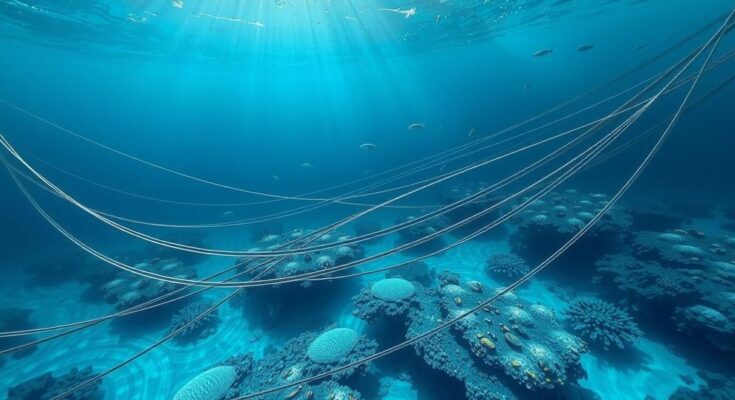Meta’s Project Waterworth aims to connect five continents via a 50,000-kilometer submarine cable, enhancing global communication while promoting technological development. Modern submarine cables, specifically SMART and OFS categories, can also collect environmental data aiding in climate change monitoring. However, slow adoption is hindered by regulatory, financial, and security concerns.
Last month, Meta announced its initiative to construct the world’s longest submarine communication cable, named Project Waterworth. This 50,000-kilometer cable aims to enhance connectivity and drive technological growth across continents, including the United States, India, and Brazil. Submarine cables have played a critical role in global connectivity since the first cable was laid across the Atlantic in 1858.
Currently, approximately 1.4 million kilometers of submarine cables exist globally, which are capable of transmitting data at speeds of up to 300 terabits per second. However, these cables serve a greater purpose beyond telecommunications. Recent advancements have demonstrated that modern submarine cables can be instrumental in addressing environmental threats such as climate change and natural disasters.
SMART cables, which stands for Scientific Monitoring and Reliable Telecommunications, are equipped with sensors that collect vital oceanic environmental data. This initiative, supported by entities like the International Telecommunications Union and UNESCO, focuses on improving early warning systems for natural calamities like tsunamis and tracking climate changes.
Another type of sensing cable called OFS, or optical fibre sensing, monitors surrounding vibrations to protect critical infrastructure from potential disruptions. Notably, a few countries such as France and Portugal are investing in these technologies, and the European Commission supports SMART cable projects as part of broader infrastructural development strategies.
Despite the potential benefits, the adoption of sensing cables remains slow due to outdated regulations, unclear business models, and perceived security risks. The current legal framework does not adequately address cables equipped with environmental sensors, complicating the permit approval process. Additionally, industry executives express concern regarding the financial viability, noting that incorporating sensors might raise costs without a clear return on investment.
Moreover, some industry experts warn that sensing-enabled cables might be construed as surveillance tools by certain governments, raising security concerns. However, the advantages of deploying SMART cables are substantial, as they can provide essential information about ocean conditions that various industries could use for risk mitigation.
The obstacles in regulatory frameworks present challenges to investments in sensing technology. Nevertheless, if regulations were modernized, initiatives like Meta’s Waterworth Project could facilitate the integration of sensors in submarine cables. Deploying sensors on less geopolitically sensitive cable branches may also advance the creation of an open-access database for ocean observation data, benefiting scientists, policymakers, and industries alike.
Countries particularly vulnerable to climate change, such as those in the Pacific, could benefit from scientific data to better understand oceanic alterations and tackle issues like rising sea levels and extreme weather. Portugal exemplifies a proactive approach towards investing in SMART cables to enhance climate data collection, demonstrating a feasible path for other nations interested in similar investments.
The idea of embedding sensors into submarine cables represents not a complete solution but an essential step toward comprehending ocean dynamics. This initiative is crucial for addressing and mitigating environmental challenges, underlining the urgency of protecting our planet from further degradation.
In conclusion, submarine cables not only facilitate global connectivity, but also present an opportunity for environmental monitoring through the integration of sensing technology. Although regulatory, financial, and security challenges currently hinder widespread adoption, proactive examples from nations like Portugal illustrate the potential benefits of such initiatives. Embracing SMART cable technology holds promise for improving climate data and thus contributes to addressing climate change and protecting vulnerable environments.
Original Source: eveningreport.nz




